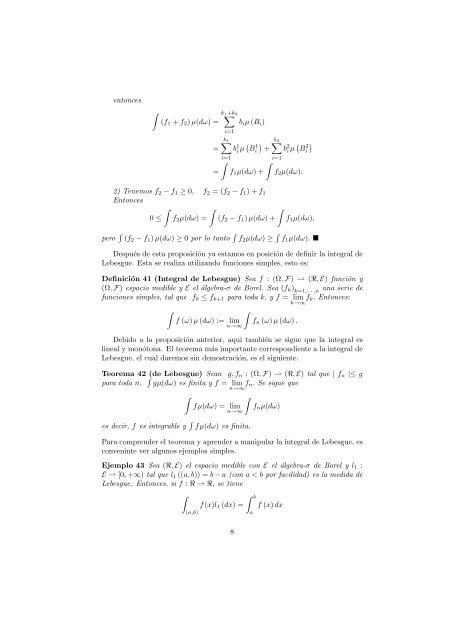ESPACIOS CON MEDIDA
ESPACIOS CON MEDIDA
ESPACIOS CON MEDIDA
You also want an ePaper? Increase the reach of your titles
YUMPU automatically turns print PDFs into web optimized ePapers that Google loves.
entonces∫(f 1 + f 2 )µ(dω) =k∑1+k 2i=1i=1b i µ (B i )∑k 1= b 1 i µ ( Bi1 ) ∑k 2+ b 2 i µ ( Bi2 )i=1∫ ∫= f 1 µ(dω) + f 2 µ(dω).2) Tenemos f 2 − f 1 ≥ 0, f 2 = (f 2 − f 1 ) + f 1Entonces∫ ∫∫0 ≤ f 2 µ(dω) = (f 2 − f 1 )µ(dω) +f 1 µ(dω),pero ∫ (f 2 − f 1 )µ(dω) ≥ 0 por lo tanto ∫ f 2 µ(dω) ≥ ∫ f 1 µ(dω). Después de esta proposición ya estamos en posición de definir la integral deLebesgue. Esta se realiza utilizando funciones simples, esto es:Definición 41 (Integral de Lebesgue) Sea f : (Ω, F) ⇀ (R, E) función y(Ω, F) espacio medible y E el álgebra-σ de Borel. Sea (f k ) k=1,··· ,nuna serie defunciones simples, tal que f k ≤ f k+1 para toda k, y f = lim f k. Entonces:k→∞∫∫f (ω)µ(dω) := lim f n (ω)µ(dω).n→∞Debido a la proposición anterior, aqui también se sigue que la integral eslineal y monótona. El teorema más importante correspondiente a la integral deLebesgue, el cual daremos sin demostración, es el siguiente.Teorema 42 ∫(de Lebesgue) Sean g, f n : (Ω, F) ⇀ (R, E) tal que | f n |≤ gpara toda n, gµ(dω) es finita y f = lim f n. Se sigue quen→∞∫∫fµ(dω) = lim f n µ(dω)n→∞es decir, f es integrable y ∫ fµ(dω) es finita.Para comprender el teorema y aprender a manipular la integral de Lebesgue, esconveninte ver algunos ejemplos simples.Ejemplo 43 Sea (R, E) el espacio medible con E el álgebra-σ de Borel y l 1 :E ⇀ [0, +∞) tal que l 1 ((a, b)) = b − a (con a < b por facilidad) es la medida deLebesgue. Entonces, si f : R ⇀ R, se tiene∫∫ bf(x)l 1 (dx) = f (x)dx(a,b)8a
















